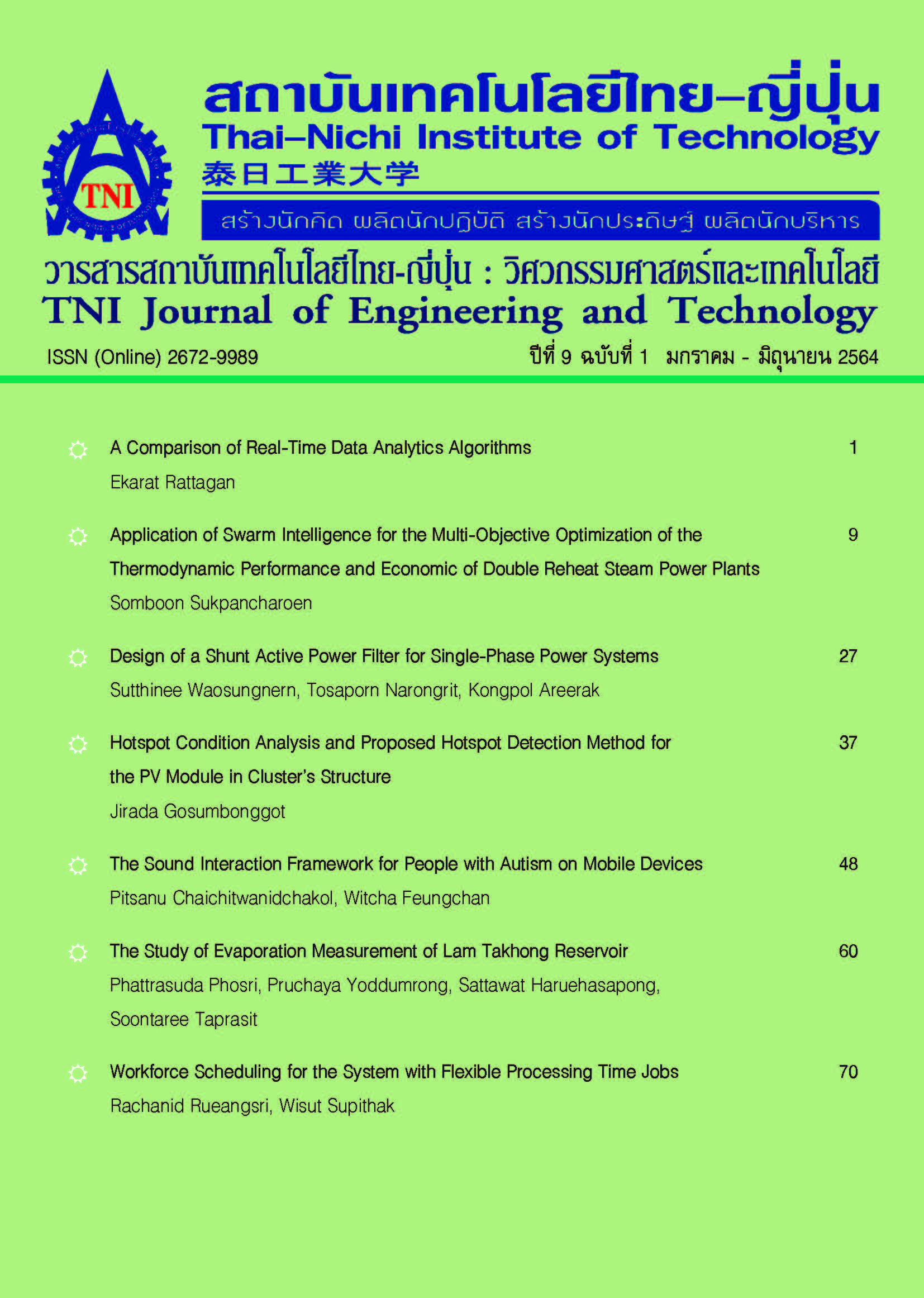The Study of Evaporation Measurement of Lam Takhong Reservoir
Main Article Content
Abstract
This research aims to find out the comparison results of evaporation value of Class A pan with the evaporation pan model constructed as the tool of the study. Two evaporation model pans made from brass with 30 - centimeters diameter (300 millimeters diameter, 200 millimeters in depth and 4 millimeters in thickness) were situated in the location at The Lam Ta Khong Operation Maintenance Project, Nakhon Ratchasima Province, during March through May. With the similar meteorological conditions, the data was continuously collected for 3 months to compare the evaporation value of the two pans with the Class A pan at the site and with the evaporation of the Penman Equation method. The results showed that the average evaporation of 30 - centimeters diameter pans were approximately 15% greater than the Class A pan, Em/Epan ratio was 1.21 and the maximum average evaporation value, which was in April at 6.03 millimeter/day. The average evaporation of the Penman Equation was approximately 30% less than the 30 - centimeters diameter pans and the maximum average evaporation value, which was in April at 5.17 millimeter/day. The average evaporation coefficient (Kp) of the 30 - centimeters diameter pans was at 0.76 which the only coefficient of evaporation in the summer season.
Article Details
Article Accepting Policy
The editorial board of Thai-Nichi Institute of Technology is pleased to receive articles from lecturers and experts in the fields of engineering and technology written in Thai or English. The academic work submitted for publication must not be published in any other publication before and must not be under consideration of other journal submissions. Therefore, those interested in participating in the dissemination of work and knowledge can submit their article to the editorial board for further submission to the screening committee to consider publishing in the journal. The articles that can be published include solely research articles. Interested persons can prepare their articles by reviewing recommendations for article authors.
Copyright infringement is solely the responsibility of the author(s) of the article. Articles that have been published must be screened and reviewed for quality from qualified experts approved by the editorial board.
The text that appears within each article published in this research journal is a personal opinion of each author, nothing related to Thai-Nichi Institute of Technology, and other faculty members in the institution in any way. Responsibilities and accuracy for the content of each article are owned by each author. If there is any mistake, each author will be responsible for his/her own article(s).
The editorial board reserves the right not to bring any content, views or comments of articles in the Journal of Thai-Nichi Institute of Technology to publish before receiving permission from the authorized author(s) in writing. The published work is the copyright of the Journal of Thai-Nichi Institute of Technology.
References
W. Boonyatharokul, Irrigation Principles, Bangkok, Thailand: Kasetsart University, Faculty of Engineering, Department of Irrigation Engineering (in Thai), 1983.
A. Rittima. (2018). Hydrology (in Thai) [Online]. Available: https://www.gooshared.com/d/NzM2Ny00
Northern Meteorological Center, “Meteorological Instruments,” (in Thai). CMMET.TMD.go.th. http://www. cmmet.tmd.go.th/instrument/instruments.php (accessed Apr. 1, 2021).
Lam Ta Khong Operation and Maintenance Project, “Lam Ta Khong operation and maintenance project,” (in Thai), 2021. [Online]. Available: http://lamtakhong-omp.rid.go.th/Lamtakhong/index.php
S. Duangdee, “The study of evaporation measurement by 30-cm. diameter zinc pan,” (in Thai), M. Eng. thesis, Department of Irrigation Engineering, Faculty of Engineering at Kamphaengsaen, Kasetsart University, Kamphaengsaen Campus, Nakhon Pathom, Thailand, 1988.
H. L. Penman, “Natural evaporation from open water, hare soil and grass,” Proceedings of the Royal Society A: Mathematical, Physical & Engineering Sciences, vol. 193, no. 1032, pp. 120–145, 1948.
V. Vudhivanich, “Calculation of ETo of Thailand by Penman - Monteith method,” (in Thai), Engineering Journal Kasetsart, vol. 10, no. 29, pp. 91–105, 1996.
A. Rittima, K. Saleekij, K. Samarnwongrak, P. Sritamma, I. Cheeranoravanich, and M. Udomthara, “The study on evaporation losses from medium and small reservoirs in Thailand,” (in Thai), Rerearch and Development Journal, vol. 24, no.1, 2013.
K. Saktrakul, “Study of water losses from Huai Pru Reservoir Nakhon Nayok Province,” (in Thai), M. Eng. thesis, Department of Irrigation Engineering, Faculty of Engineering at Kamphaengsaen, Kasetsart University, Kamphaengsaen Campus, Nakhon Pathom, Thailand, 2002.
M. E. Jensen, A. Dotan, and R. Sanford, “Penman-monteith estimates of reservoir evaporation,” in World Water and Environmental Resources Congress 2005, Anchorage, AK, USA, 2005, pp. 1-24, doi: 10.1061/40792(173)548.
W. Boonyatharokul, “Estimation of potential evapotranspiration in Thailand by using formulas based on climatological data,” (in Thai), Agriculture and Natural Resources, vol. 9, no. 1. pp. 26–34, Jun 1975.
S. Wattasirichai, “Forecasting evaporation rate from Class A Pan and analysis of reservoir evaporation,” (in Thai), M. Eng. thesis, Department of Irrigation Engineering, Faculty of Engineering at Kamphaengsaen, Kasetsart University, Kamphaengsaen Campus, Nakhon Pathom, Thailand, 1999.


